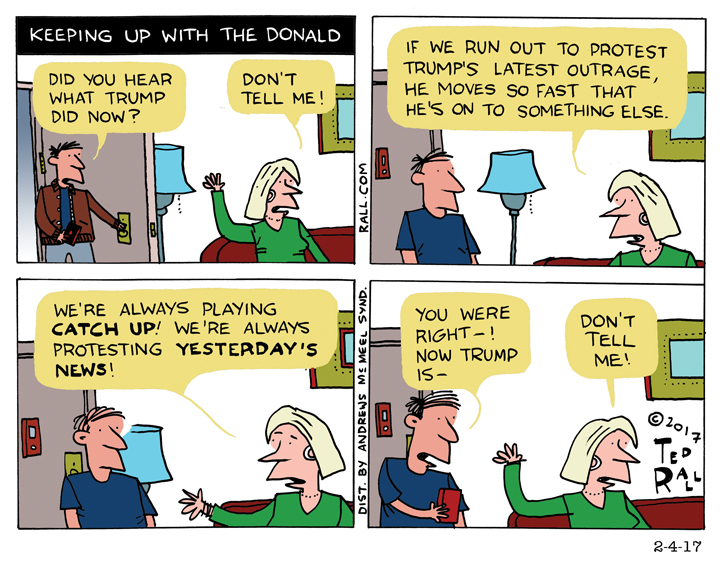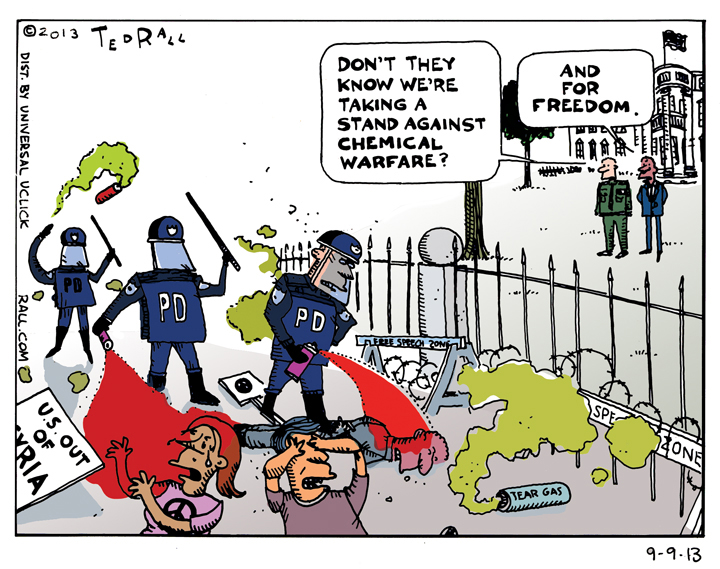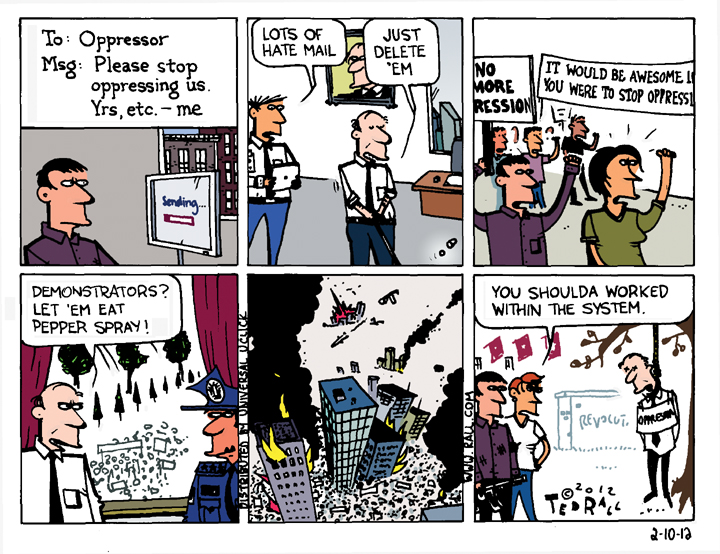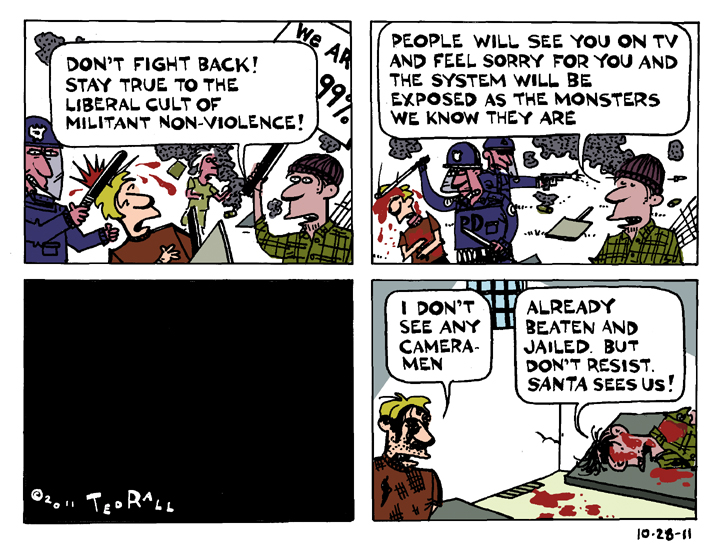What’s the point of protesting yesterday’s news? By the time your march comes together, everyone is already focused on the next outrage.
SYNDICATED COLUMN: The Women’s March Failed But Was Hopeful Too
![]() On Saturday, January 21st, three times as many people attended a demonstration against Trump as showed up the day before for his inauguration. Solidarity marches across the nation drew hundreds of thousands, perhaps a million, more.
On Saturday, January 21st, three times as many people attended a demonstration against Trump as showed up the day before for his inauguration. Solidarity marches across the nation drew hundreds of thousands, perhaps a million, more.
The turnout was impressive. It vexed the new president. But what did the Women’s March mean?
Despite what pundits said, the Women’s March was not a movement. Nor was it the beginning of a movement.
It was a moment: a show of hands: “I’m against Trump,” these women (and men) told the world. Question was, who/what do they want to replace him?
As Occupy Wall Street instigator Micah White pointed out, Women’s Marchers didn’t issue any demands, much less posit a desire to achieve political power. “Without a clear path from march to power, the protest is destined to be an ineffective feel-good spectacle adorned with pink pussy hats,” he warned. Like other protests of the last few decades, the Women’s March was a spasm, a spontaneous expression of disgust and outrage doomed to lead nowhere.
If you don’t demand anything, (or if you demand everything) how will you get it?
If you don’t pose a threat to the establishment, why should they feel scared?
At the risk of both mansplaining and leftsplaining, a show of hands does matter. Events like the Women’s March are significant because American politics is centered (pun intended) around the fiction that leftist political movements taken for granted in other nations — communism, socialism and left anarchism — have no presence at the ballot box or in the news media in the U.S. because American voters aren’t interested.
Moments like Saturday prove that’s a lie.
The New Left was the last organized left-wing mass movement in American history. Since the organized Left collapsed in the early 1970s, we’ve seen other moments like Saturday, indications that there are Americans, tens of millions of them, whose politics fall to the left of the fake-left Democratic party and the lockstep center-right corporate media apparatus that props up it and its “rival” Republican brand. Signs that this Left-in-waiting really exists belie the party line that there’s no market for hammers-and-sickles in the good ol’ U.S.A.
Even during the somnolent 1980s, hundreds of thousands showed up to protest Reagan at demonstrations like Solidarity Day. There were violent, effective eco-terrorist attacks and anti-globalization/WTO protests like the Battle of Seattle in the 1990s. Millions marched against the 2003 invasion of Iraq. This decade brought us Occupy Wall Street and Bernie Sanders’ surprisingly popular presidential primary challenge, and polls that find that 37% of Americans would get rid of capitalism — the economic system we’re constantly being told is more sacred and popular than Jesus, mom and apple frappuccino.
These political impulses — opposition to war and militarism, fighting job-exporting free-trade agreements and suspicion of unfettered capitalism — have no place in the Democratic or Republican parties. To the contrary: war, free trade and letting business run wild are nastily bipartisan.
So more than a third of Americans find nothing of interest to buy in the American marketplace of political ideas. That’s a vast untapped pool of potential “customers.” These people — I’d say voters, but many of them don’t bother to vote because they hate both parties — represent an inefficiency in the market. Moments like Occupy, Bernie and the Women’s March remind us of the existence of this Left-in-waiting. Someday, obviously, someone or someones will build an organization that attracts America’s long-ignored leftists and channels their energies into something powerful enough to achieve power and smart enough to govern.
Until then, the real left will be co-opted by the Democrats.
Which is what happened to the Women’s March.
To be sure, many Women’s Marchers were Hillary Clinton Democrats. The “Love Trumps Hate” signs, hand-lettered rather than printed by the DNC as they were during the fall campaign, and the Hillary buttons, evidenced that. Yet many more of the demonstrators were Bernie Sanders progressives, socialists and communists who want to see radical change in society and the economy — and these good leftists (a third of the country, most of the left overall) allowed themselves to go unrepresented.
A good indication that the Women’s March got co-opted into a Democratic boo-hoo Hillary/Cory Booker-in-2020 pep rally was that the speakers were limited to celebrity millionaire liberal Democrats like Michael Moore, Ashley Judd and Gloria Steinem and defanged ex-radicals like Angela Davis. Had this been a militant action (i.e., one that might frighten Trump and the GOP), or a coalition of liberals who welcomed and respected their leftist allies rather than merely wanting to vampirize their righteous anger and energy into midterm votes, the roster of speakers would have included people calling for revolutionary change and action outside of the existing system. There would also have been some radical activists you’d never heard of who do important work.
Celebrity liberalism and pleas to vote Democratic are where the Left goes to die.
No wonder the Women’s March was doomed to join the list of fruitless liberal marches! Because they’re Democrats, none of the speakers suggested scrapping the whole sick system of systemized poverty, industrialized prisons, war and slave labor altogether. Instead marchers got a washed-up documentary filmmaker urging them to memorize a phone number they could use to call Congress because, yeah, that’s going to do so much good, especially these days with Republicans in charge of everything.
Still, despite the Democratic BS, those huge crowds were glorious. They showed up, they were heard, they hint at the better country we could have.
May they soon get the radical, genuine political movement they and the world deserve.
(Ted Rall is author of “Trump: A Graphic Biography,” an examination of the life of the Republican presidential nominee in comics form. You can support Ted’s hard-hitting political cartoons and columns and see his work first by sponsoring his work on Patreon.)
SYNDICATED COLUMN: Ah, To Be Young And In Hate
America’s New Radicals Attack a System That Ignores Them
“Enraged young people,” The New York Times worries aloud, are kicking off the dust of phony democracy, in which “the job of a citizen was limited to occasional trips to the polling places to vote” while decision-making remains in the claws of a rarified elite of overpaid corporate executives and their corrupt pet politicians.
“From South Asia to the heartland of Europe and now even to Wall Street,” the paper continues, “these protesters share something else: wariness, even contempt, toward traditional politicians and the democratic political process they preside over. They are taking to the streets, in part, because they have little faith in the ballot box.”
The rage of the young is real. It is justified. It is just beginning to play out.
The political class thinks it can ignore the people it purports to represent. They’re right–but not forever. A reckoning is at hand. Forty years of elections without politics will cost them.
Americans’ pent-up demand for a forum to express their disgust is so vast that they are embracing slapdash movements like Occupy Wall Street, which reverses the traditional tactic of organizing for a demonstration. People are protesting first, then organizing, then coming up with demands. They have no other choice. With no organized Left in the U.S., disaffected people are being forced to build resistance from the ground up.
Who can blame young adults for rejecting the system? The political issue people care most about–jobs and the economy–prompts no real action from the political elite. Even their lip service is half-assed. Liberals know “green jobs” can’t replace 14 million lost jobs; conservatives aren’t stupid enough to think tax cuts for the rich will help them pay this month’s bills.
The politicians’ only real action is counterproductive; austerity and bank bailouts that hurt the economy. Is the government evil or incompetent? Does it matter?
Here in the United States, no one should be surprised that young adults are among the nation’s angriest and most alienated citizens. No other group has been as systematically ignored by the mainstream political class as the young. What’s shocking is that it took so long for them to take to the streets.
Every other age groups get government benefits. The elderly get a prescription drug plan. Even Republicans who want to slash Medicaid and Medicare take pains to promise seniors that their benefits will be grandfathered in. Kids get taken care of too. They get free public education. ObamaCare’s first step was to facilitate coverage for children under 18.
Young adults get debt.
The troubles of young adults get no play in Washington. Pundits don’t bother to debate issues that concerns people in their 20s and 30s. Recent college graduates, staggering under soaring student loan debt, are getting crushed by 80 percent unemployment–and no one even pretends to care. Young Americans tell pollsters that their top concerns are divorce, which leaves kids impoverished, and global warming. Like jobs, these issues aren’t on anyone’s agenda.
This pot has been boiling for decades.
In 1996 I published “Revenge of the Latchkey Kids,” a manifesto decrying the political system’s neglect and exploitation of Generation X, my age cohort, which followed the Baby Boomers.
We were in our 20s and low 30s at the time.
Un- and underemployment, the insanity of a job market that requires kids to take out mortgage-sized loans to attend college just to be considered for a low-paid entry-level gig in a cube farm, the financial and emotional toll of disintegrating families, and our fear that the natural world was being destroyed left many of my peers feeling resentful and left out–like arriving at a party after the last beer was gone.
Today the oldest Gen Xers are turning 50. Life will always be harder for us than it was for the Boomers. If I had to write “Latchkey Kids” for today’s recent college grads, it would be bleaker still. Today’s kids–demographers call them Gen Y–have it significantly worse than we did.
Like us, today’s young adults get no play from the politicians.
The debts of today’s Gen Yers are bigger ($26,000 in average student loans, up from $10,000 in 1985). Their incomes are smaller. Their sense of betrayal, having gone all in for Obama, is deeper.
Young adults turned out big for Obama in 2008, but he didn’t deliver for them. They noticed: The One’s approval rating has plunged from 75 percent among voters ages 18-29 when he took office in January 2009 to 45 percent in September.
Politicians like Obama ignore young adults, especially those with college degrees, at their–and the system’s–peril. Now, however, more is at stake than Obama and the Democrats’ 2012 election prospects. The entire economic, social and political order faces collapse; young people may choose revolution rather than accept a life of poverty in a state dedicated only to feeding the bank accounts of the superrich.
As Crane Brinton pointed out in his seminal book “The Anatomy of Revolution,” an important predictor of revolution is downward mobility among strivers, young adults whose education and ambition would traditionally have led to a brighter future.
In February Martin Wolf theorized in The Financial Times that the Arab Spring rebellions in Egypt and Tunisia owed their success to demographics; those countries have more young people than old ones. On the other hand “middle-aged and elderly rig political and economic life for their benefit in the U.K. [he could also have said the U.S.]: hence the way in which policies on housing or education finance are weighted against the young.”
Right here and right now, though, the young and the old are on the same side. Though the young are getting screwed the hardest, almost everyone else is getting screwed too. And with 80 percent unemployment, the young have a lot of free time to rise up.
(Ted Rall is the author of “The Anti-American Manifesto.” His website is tedrall.com.)
COPYRIGHT 2011 TED RALL





